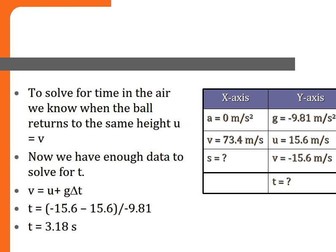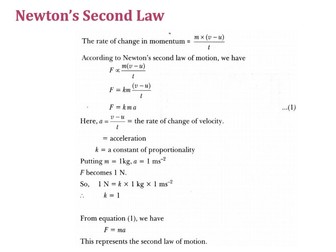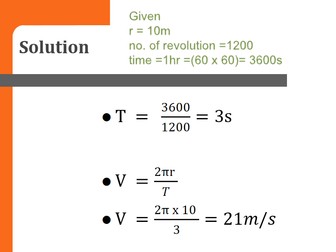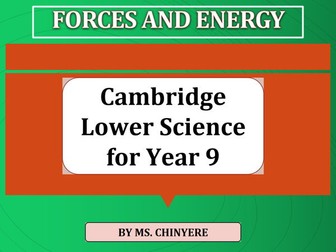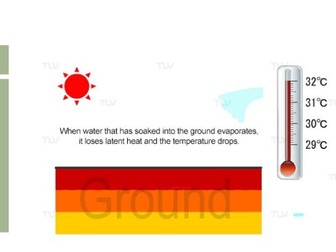Newtons laws of Motion
<p>Detailed notes and interactive activities for effective teaching and learning</p>
Circular Motion
<p>Detailed notes and interactive activities for effective Circular motion teaching and learning.</p>
Where does the energy go?
<p>This educational resource helps students understand energy transfer, useful and wasted energy, and dissipation. Features include:</p>
<ul>
<li>Clear definitions of key terms</li>
<li>Real-life examples (burning wood, walking upstairs, using electronics)</li>
<li>Interactive student activities (discussions, peer assessments, collaborations)</li>
<li>Teacher guidance for effective instruction</li>
</ul>
Energy
<p>The “Energy” teaching resource is likely focused on helping students understand the various forms of energy and how energy is transformed or transferred in different situations. This presentation may include definitions, examples of energy types (such as kinetic, potential, thermal, and electrical), and key principles like the conservation of energy. Additionally, it might use diagrams, charts, and real-life examples to explain concepts like energy efficiency, energy transfer methods, and how energy is stored in different systems. It could also contain interactive elements or exercises to reinforce learning</p>
Properties of Materials for year 8
<p>The teaching resource titled Properties of Material for Year 8 is a Power-Point presentation designed for Cambridge Lower Secondary Science students.</p>
<p>It covers the topic of properties of materials, focusing on concepts like dissolving, solubility, and solutions.</p>
<p>The presentation includes key definitions, examples, and explanations of terms such as solvent, solute, and solution.</p>
<p>It also discusses the difference between dilute and concentrated solutions, the effect of temperature on solubility, and introduces chromatography as a method to separate dissolved substances.</p>
<p>The resource is interactive, featuring starters, plenary activities, and prompts for students to engage in discussions, reflect on their understanding, and plan investigations related to solubility</p>
undefined
Forces and Energy for Year 9
<p>The “Forces and Energy” Power-Point presentation is a thorough teaching resource designed for a full-term Year 9 Science course. It encompasses a range of topics, including density, heat, temperature, energy conservation, thermal energy transfer, and cooling methods. The resource features:</p>
<ul>
<li>Clear learning objectives</li>
<li>Engaging starter activities</li>
<li>Detailed explanations of key concepts</li>
<li>Interactive exercises (calculations, discussions) to reinforce understanding</li>
<li>Real-life examples to illustrate concepts</li>
<li>Plenary activities to assess comprehension and encourage reflection</li>
</ul>
<p>This comprehensive resource provides a structured and engaging approach to teaching forces and energy, supporting students throughout the term.</p>
Forces and Energy for year 8
<p>The teaching resource titled Forces and Energy for Year 8 is a comprehensive Power-Point presentation designed for Cambridge Lower Secondary Science.</p>
<p>It covers key concepts related to forces and energy, tailored specifically for Year 8 students. The resource includes learning objectives such as understanding how forces act on objects, recognizing balanced and unbalanced forces, and understanding force diagrams.</p>
<p>The presentation is rich with examples, exercises, and activities that encourage students to engage with the material, including group discussions, problem-solving tasks, and real-world applications.</p>
<p>It also includes visual aids, such as force diagrams and distance-time graphs, to help students grasp complex concepts. The resource is structured to facilitate active learning and critical thinking, ensuring that students can apply their knowledge to various scenarios and understand the underlying principles.</p>
Cells, Tissues, Organs and Organ System
<p>The teaching resource titled “Cells, Tissues, and Organs” is a PPT presentation designed for a year 7 to year 9 science lesson.<br />
The resource covers key concepts such as the hierarchy of biological organization, including cells, tissues, organs, and organ systems.<br />
It explains the functions and interconnections of various organs and organ systems within the human body.<br />
With interactive discussions and activities, this comprehensive resource engages students in understanding the intricacies of multicellular organization, making it an ideal tool for teaching the biology of living organisms.</p>
Specialised Cells
<p>Specialized Cells<br />
Structures<br />
Adaptation<br />
Functions<br />
Class Activity</p>
Physical Quantities and Measurement
<ul>
<li>Lesson Objectives</li>
<li>Starter for the lesson</li>
<li>Fundamental quantities and unit</li>
<li>Physical Quantity Prefixes and meaning</li>
<li>Measurement of length using meter rule, vernier calliper, and micrometer screw gauge</li>
<li>practice questions for vernier calliper and Micrometer screw gauge</li>
<li>
<ul>
<li>general revision questions</li>
</ul>
</li>
</ul>
Heat and Temperature
<p>Slide 1: Title Slide<br />
Slide 2: Lesson Objectives<br />
Slide 3: Starter<br />
Slide 4, 5 , 6 , 7: What thermal Energy?<br />
Slide 8, 9 10: What is Temperature?<br />
Slide 11: Heat and Temperature<br />
Slide 13: Plenary<br />
Slide 14: Sucess Criteria</p>
Cooling By Evaporation
<p>Slide 1: Title Slide<br />
Slide 2: Learning Objectives</p>
<ul>
<li>Keywords<br />
Slide 3:Heat and particle movement<br />
Slide 4, 5 and 6: how evaporation causes cooling and examples<br />
Slide 5: Plenary<br />
Success Criteria</li>
</ul>
